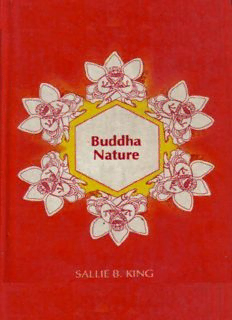
Buddha Nature PDF
Preview Buddha Nature
Bibliotheca Indo-Buddhica Series-No. 103 BUDDHA NATURE Sallie B. King SRI SATGURU PUBLICATIONS A Division of INDIAN BOOKS CENTRE DELHI-INDIA Published by: SRI SATGURU PUBLICATIONS Indological And Oriental Publishers A Division of Indian Books Centre 40/5,Shakti Nagar, Delhi-110007 (INDIA) © 1991 State Universliy of New York All Rights Reserved The Publication of this Book in India is made by permission of State University of New York Press. First Indian Edition : Delhi 1992 ISBN 81-7030-308-9 No part of this book may be used or reproduced in any manner whatsoever without written permission except in the case of brief quotations embodied in critical articles and reviews. Printed at: D.K. Fine Art Press, Delhi. PRINTED IN INDIA For my parents, James Forrest King, Sr. and Carolyn Prout King CONTENTS Preface IX Abbreviations • xi Chapter One: Introduction A. The Role of the Buddha Nature Concept B. Terms G. History D. The Text of the Buddha Nature Treatise 23 E. The Buddha Nature Treatise and Chinese Buddhist Thought Chapter Two: The Concept of Buddha Nature 2 A. Taking the Semantic Ascent B. Refutation of Other Views C. The Essence of Buddha Nature 27 1. The Buddha Nature as Three Causes 2. The Three Natures (Trisvabhava) 2 3. Tathagatagarbha 3 Chapter Three: Soteriology: Buddha Nature as the Practice of Buddhism 9 4 A. Asrayaparavrtti B. Dharmakaya and Nirvana 4 G. Trihaya: Sambhogakaya and Nirmdnakaya D. The Relationship Between Person and Buddha 4 9 4 : 11 0 0 5 5 6 0 7 8 2 8 V 7 8 5 2 0 BUDDHA NATURE Chapter Four: Dereification of Self and Mind A. The “Own-Nature” of Buddha Nature 83 B. Atmapdramita C. Self 8 6 D. Pure Mind rj E. Dharmakaya and ‘‘Self’ 9 4 F. Mind 2 9 Chapter Five: Ontology: Monism vs. Nondualism A. All Sentient Beings Possess the Buddha Nature o93 B. The Paramita G. Sunya-Asunya o4 D. Buddha Nature Exists Aboriginally E. Unborn and Unchanging o7 Chapter Sfx: Engaging in Spiritual Cultivation 7 11 Chapter Seven: Buddha Nature and the Concept of Person 7 12 A, The Ontological-Metaphysical Dimension B. The Existential Dimension 9 G. A Final Question Chapter Eight: Retrospective and Prospective 14 A. Retrospective: Summary of the Text 0 B. The Buddha Nature Treatise and Chinese Buddhist Thought 3 G. Buddha Nature Thought and Western Buddhism Notes 3 3 Glossary 3 4 Index 5 6 5 9 5 viii 5 6 Preface It is a pleasure to express my gratitude for the help of the many persons and institutions who supported my work. The National Endowment for the Humanities funded this project in 1985 with a Summer Stipend that supported the early stages of the book. Portions of this book appeared in journal articles as Sallie B. Ring, “Buddha Nature and the Concept of Person,” Philosophy East and West 39, no. 2 (1989), published by the University of Hawaii Press; and Sallie Behn King, “The Buddha Nature: True Self as Action," Religious Studies 20 (1984), published by Cambridge University Press. My appreciation goes to these journals and presses for their.permission to publish this material. I especially thank Professor Leon Hurvitz for checking many of my Chinese translations against the original. Thanks also to Professor Minoru Kivota for introducing me to Buddha nature thought and raising the issue of monism for me, to Professor Thomas Dean for thinking through philosophical issues with me, and to Professor John Keenan for reading the manuscript and making helpful suggestions, especially on Yogacara matters (this despite the fact that he disagrees with my major thesis). My thanks to the Series Editor, Kenneth Inada, for recommending additions to the book that have considerably strengthened it. Whatever shortcomings remain in this work are clearly my responsibility alone. Finally, thanks to my husband for his constant practical and moral support. The romanization system used in this work is the Pinyin system. For the convenience of those more familiar with the Wade-Giles system,I have added Wade-Giles romanizations in parentheses after the Pinyin romanization the first time I introduce a familiar term or ix PREFACE name. A glossary of Chinese characters can be found at the back of the book. I have conceived of this book not only as a discussion of Buddha nature thought, but also as an introduction to some important themes in Chinese Buddhist thought. Though I require most of the book to develop these themes, I have listed them at the end of the Introduction so that the reader who is especially interested in this facet of the book may bear these themes in mind as she or he reads. In the final chapter I focus on these themes directly. x
Description: